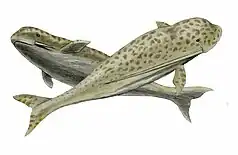Africanacetus
Africanacetus is an extinct genus of ziphiid cetacean known from skulls found in seafloor sediments of Late Miocene to Early Pliocene age off the coasts of South Africa (Banzare Bank) and Brazil (São Paulo Ridge).[1]
| Africanacetus | |
|---|---|
| Scientific classification | |
| Domain: | Eukaryota |
| Kingdom: | Animalia |
| Phylum: | Chordata |
| Class: | Mammalia |
| Order: | Artiodactyla |
| Infraorder: | Cetacea |
| Family: | Ziphiidae |
| Genus: | †Africanacetus Bianucci et al. 2007 |
| Species | |
| |
Systematics
Two species are known, A. ceratopsis and A. gracilis. Both are distinguished by their cranial proportions, with A. gracilis having a more slender skull than A. ceratopsis.[2][3]
References
- Africanacetus at Fossilworks.org
- G. Bianucci, O. Lambert, and K. Post. 2007. A high diversity in fossil beaked whales (Mammalia, Odontoceti, Ziphiidae) recovered by trawling from the sea floor off South Africa. Geodiversitas 29(4):561-618.
- Ichishima, H., A.H.Augustin, T. Toyofuku, and H. Kitazato. 2016. A new species of Africanacetus (Odontoceti: Ziphiidae) found on the deep ocean floor off the coast of Brazil. Deep Sea Research Part II: Topical Studies in Oceanography. Online Early.
This article is issued from Wikipedia. The text is licensed under Creative Commons - Attribution - Sharealike. Additional terms may apply for the media files.

